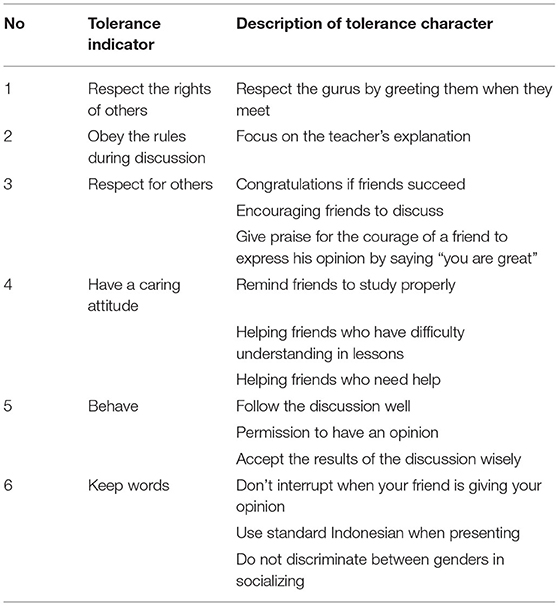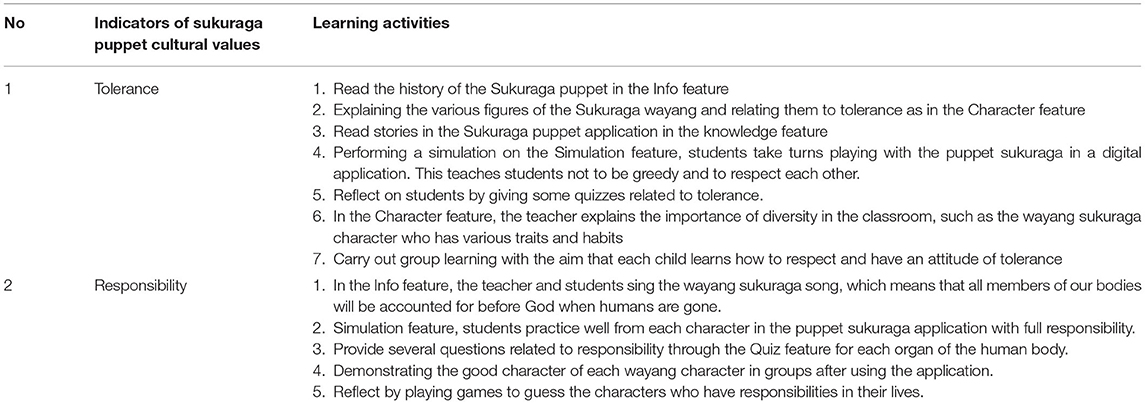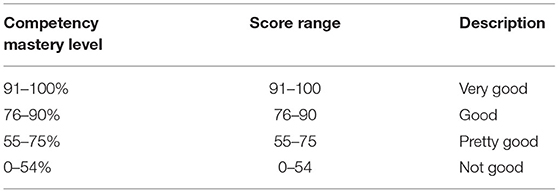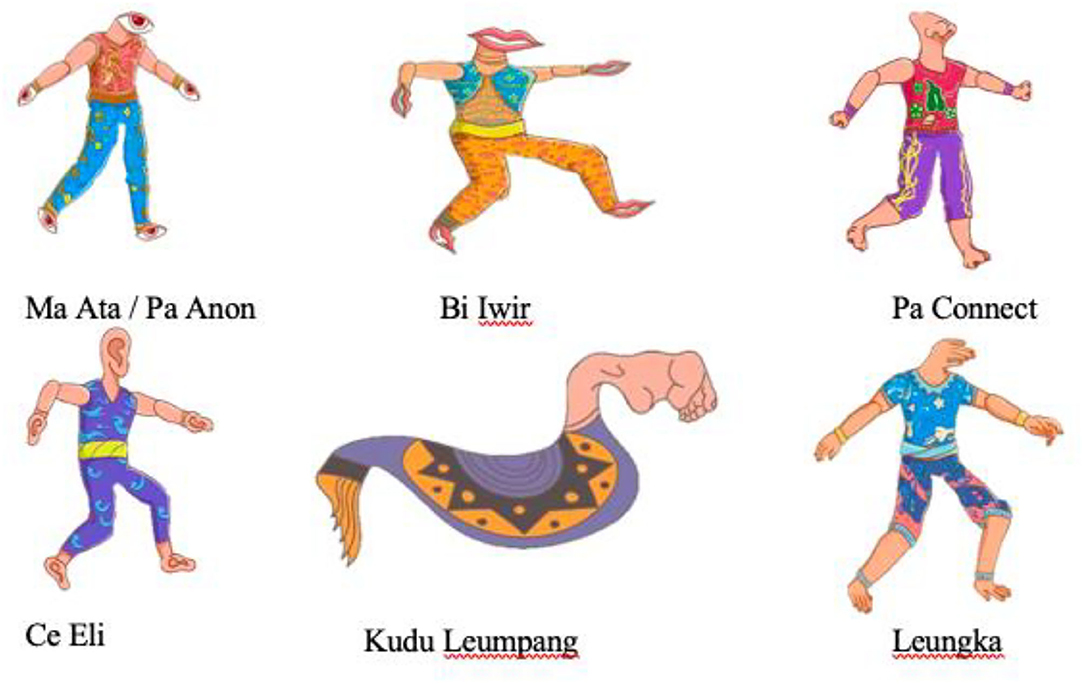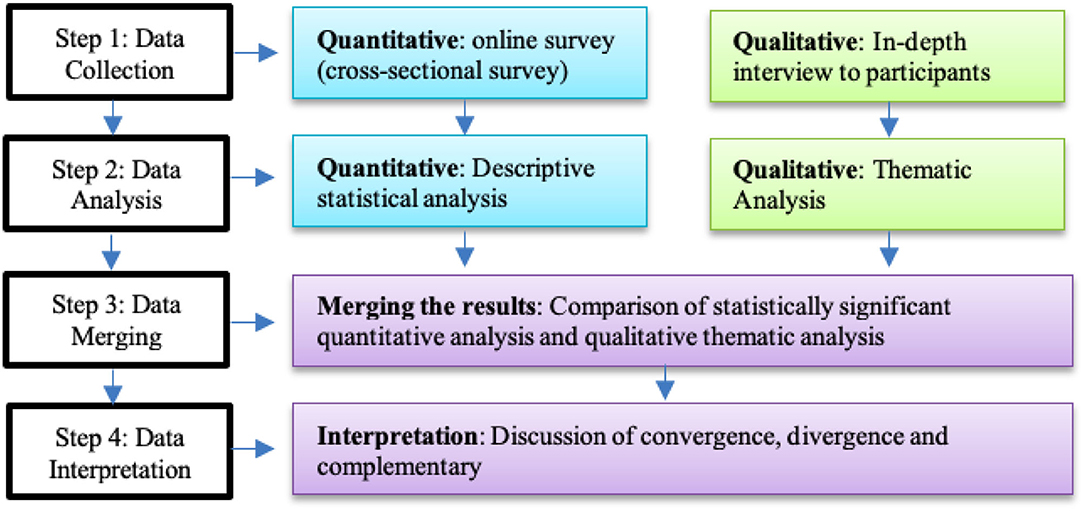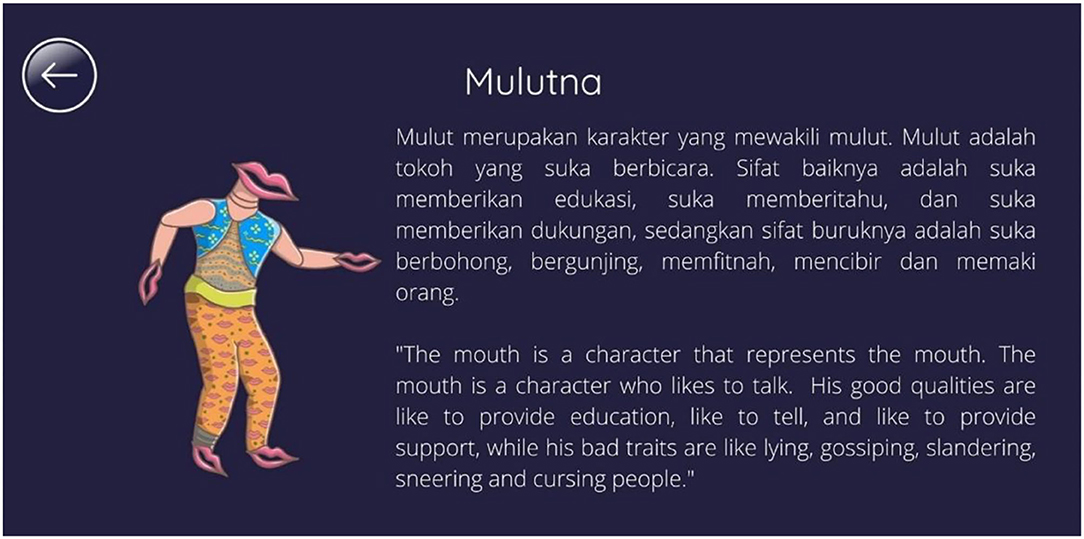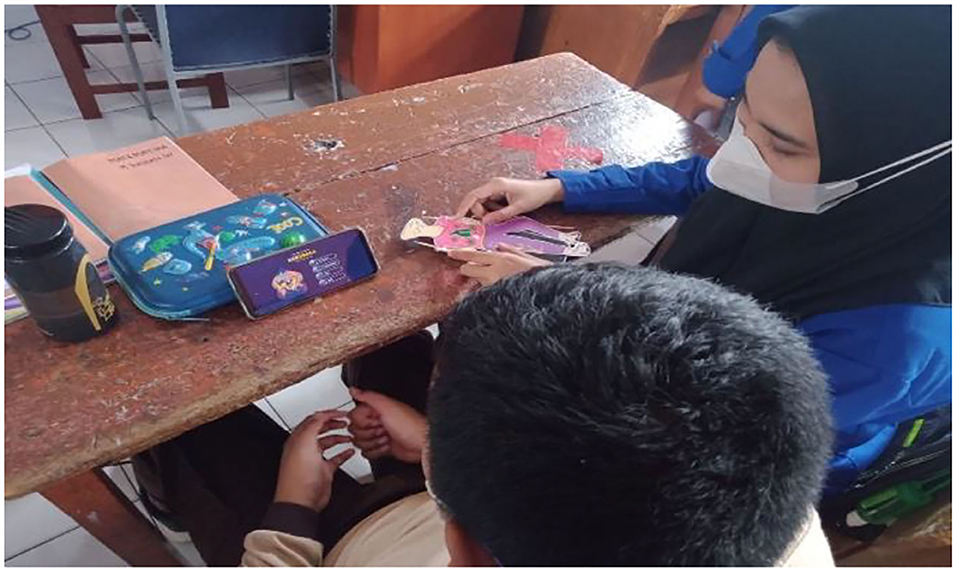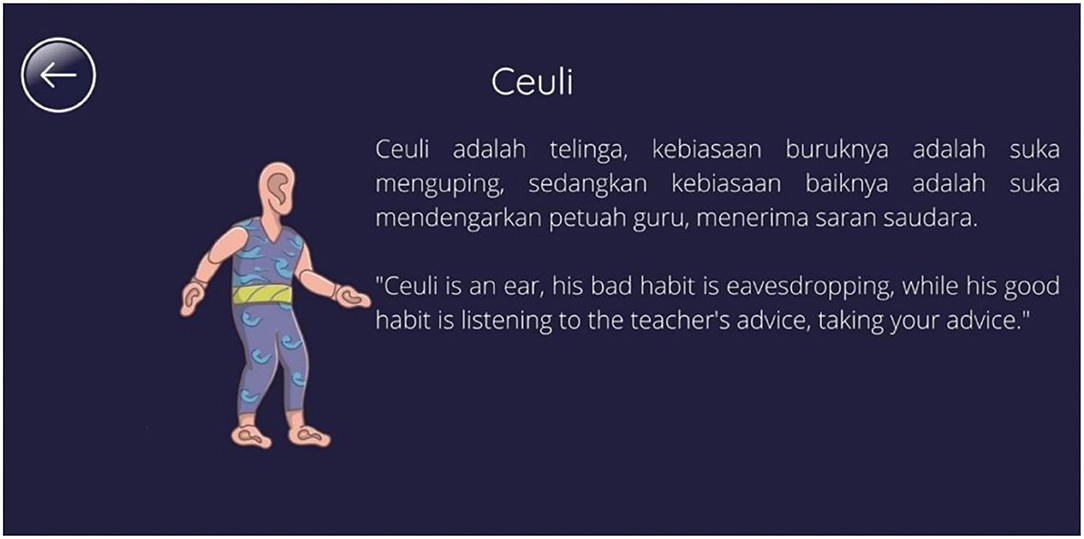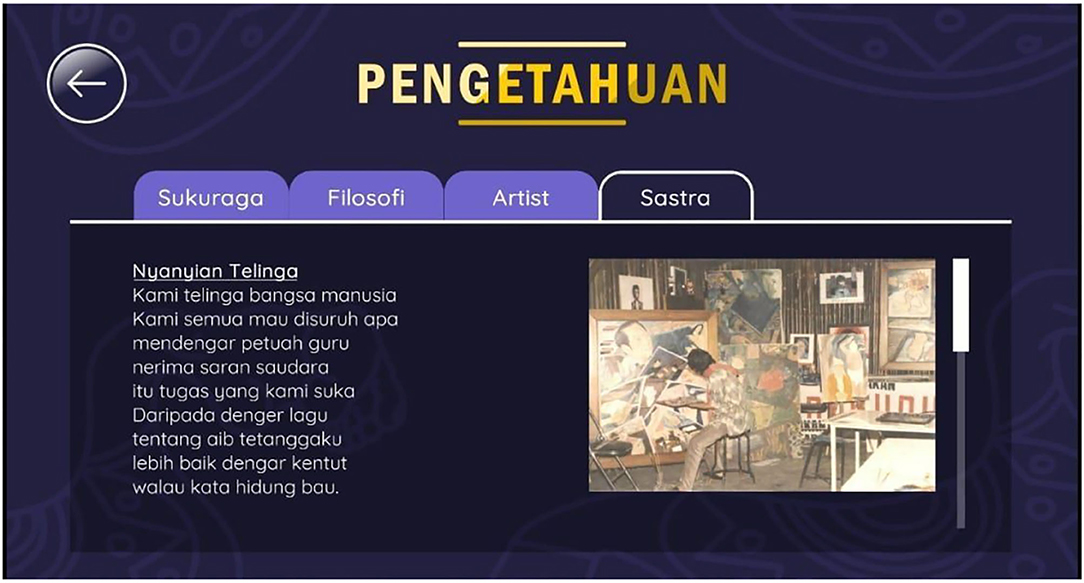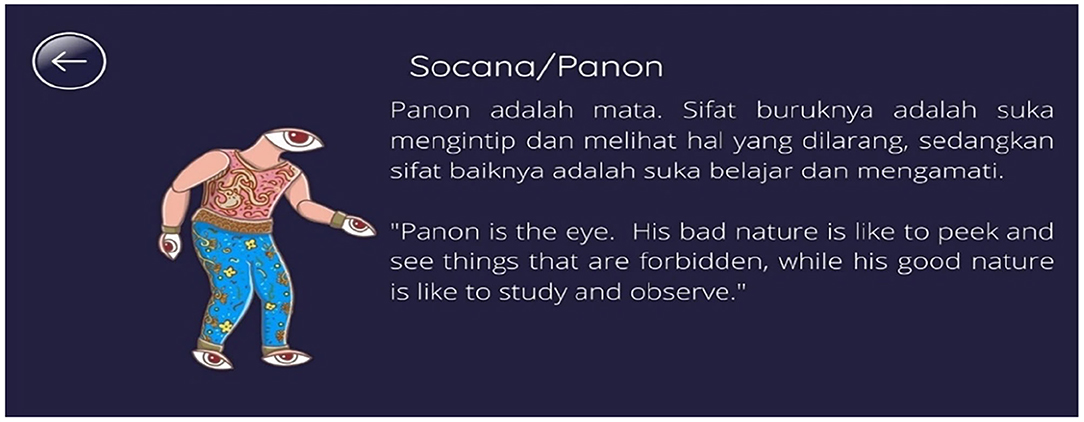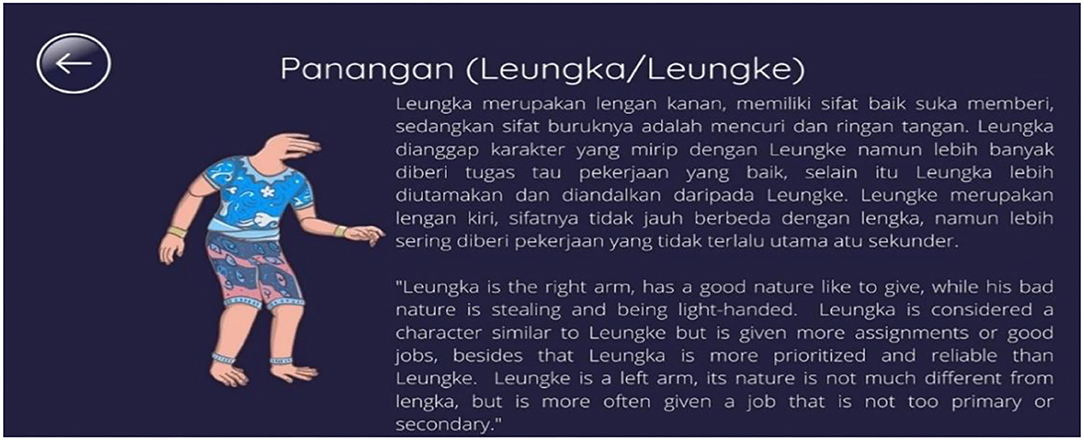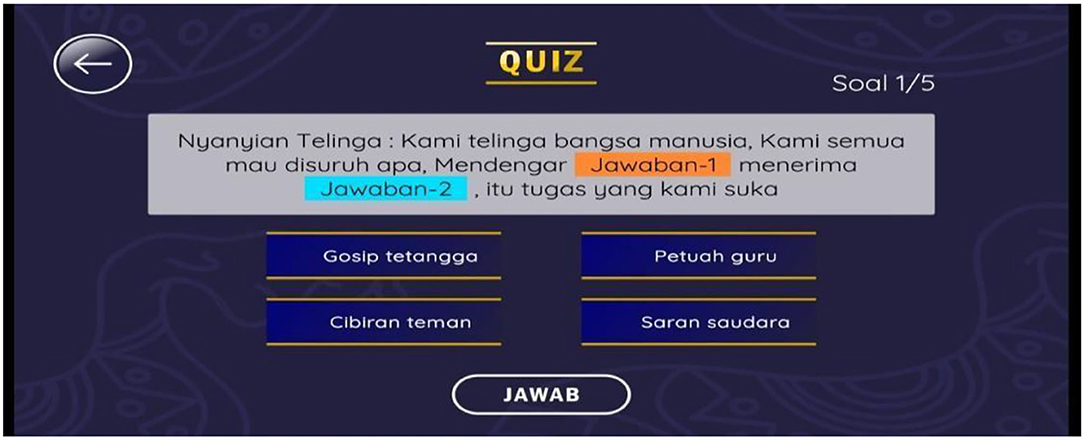- 1Department of Primary Teacher Education, Faculty of Teacher Training and Education, Universitas Muhammadiyah Sukabumi, Sukabumi, Indonesia
- 2Department of Basic Education, School of Postgraduate Studies, Universitas Negeri Jakarta, Jakarta, Indonesia
- 3Department of Primary Education, Faculty of Education, Universitas Negeri Jakarta, Jakarta, Indonesia
- 4Department of Pancasila and Civics Education, Faculty of Social Science, Universitas Negeri Jakarta, Jakarta, Indonesia
The purpose of this study was to analyze the character development of students through the use of the Puppet Sukuraga application. It can be seen that, during the Covid-19 pandemic, fulfilling the affective dimension tended to be ignored by teachers, who instead emphasized the cognitive dimension. In the affective dimension, Puppet Sukuraga is used as a character education tool in the form of applications that can develop students' character. This puppet can also be used on mobile phones by students who understand the Sukuraga wayang in depth. This study uses a mix-method conducted in one of the elementary schools in Indonesia that already uses the Puppet Sukuraga application. The number of participants in this study were two 10 teachers and 60 students in the second grade, so that overall, there were 60 participants. Data is provided in the form of a detailed description of the subject's activities from the subject's perspective through interviews and group discussion forums. Online survey for the descriptive statistical analysis was used and in-depth interviews were also used for teachers and students. It was conducted 45 min before and after learning in class. The results of the study show that the use of the Puppet Sukuraga application can develop students' character, particularly characteristics of tolerance and responsibility. Students' tolerance is more developed, and it can be seen from the attitude of respect for differences in religion, ethnicity, habits, and differences of opinions. The characteristic of responsibility is also more developed, such as being responsible for their duties in doing homework, being responsible for carrying out the teacher's orders, and being responsible for carrying out useful activities. This research has implications for elementary school teachers in Indonesia during the limited online and face-to-face learning period. It can be concluded that the cultural values on the Sukuraga Puppet Application can help teachers in schools teach students about character enhancement.
Introduction
There is a general agreement in the field of education that shows that the affective dimension is ignored by some teachers in schools (Carlsen, 2019). The affective dimension is the basis of students who have an influence on their presence in the social environment, this character is seen as very important to anticipate the phenomenon of “social relationship inclusion” as a consequence of physical and social situations and social separation from others. Socio-psychological phenomena are seen as variables of self-orientation, distraction, friction, and inactivity (Walker, 2020). This is the reason why character education is very important to be applied in elementary schools because it is to revive the character of the Indonesian nation's children which has begun to fade (Shoshani, 2019). Long-distance character education must be carried out on a massive scale; the implementation of character education in elementary schools is predicted to be the answer to social problems that exist in society (Foley, 2016).
A good national character must be formed and educated as early as possible so that the community is ready to instill good traits and behavior from an early age to reduce the number of antisocial cases. This is a portrait of the declining character of the nation, especially the characteristics of tolerance and responsibility (Gander et al., 2021). Based on the Government Decree (2021) regarding Guidelines for the Implementation of Learning in the Pandemic Period, learning is carried out in a limited face-to-face manner where some students study at home and some study at school. As result of offline observations in schools, teachers still need learning media that can be used in class or home. Teachers in the class find problems of intolerance, dishonesty, lack of responsibility, and lack of discipline (Sarkadi et al., 2020a).
Solutions to this problem include giving reprimands and advice, instilling an attitude of honesty in students, the teacher's firm attitude to students, internalizing character values into daily behavior through the training process both inside and outside the classroom as well as eye contact, and lessons and books or rewards for students which can later be conveyed to parents regarding students' attitudes toward responsibility (Cohen, 2016; Jones, 2018; Juliana Jaya et al., 2020). This effort can be a reference or follow-up for teachers and parents in the process of developing character in students and their surroundings. Quality characteristics must be taught from an early age, especially in elementary school-age children. Some of the characteristics that need to be instilled in children are moral norms and values such as honesty, discipline, independence, hard work, creativity, respect for others, responsibility, love for the homeland, leadership, and justice (Thumel et al., 2020).
Educating students to have good morals does not need to imitate external values. It is because the values that exist outside are not necessarily compatible with our nation, because every nation has its own culture. Puppets are a part of the nation's cultural heritage that must be preserved by the Indonesian people (Fredin and Jogmark, 2017; Campbell, 2018). Its use as a medium of character education can be a component in supporting the formation of the character of the nation's children while maintaining its existence as a national culture. The value of character education in wayang shows has recently faded because it is only character tourism in the words of the puppeteer, but not in the whole wayang show. This often happens because wayang performances have shifted from rituals aimed at entertainment (Fajrie et al., 2021).
Previous research using wayang can develop children's language development even in the form of finger puppets (Domek et al., 2020). Further research has been conducted by Wins (2020) who showed that hybrid character education through the use of puppet media can develop one's personality (Wiśniewska, 2020). By empowering the use of wayang in learning, such as wayang sukuraga, it is hoped that later our generation will recognize, understand, and appreciate their own culture and creativity. All of that is important for the formation of national identity because it is a process of nation regeneration (Halimah et al., 2020). Puppet Sukuraga as an original Indonesian puppet has differences from other puppets in Indonesia. As a result of media development research, Wayang Sukraga is present in the form of an application that can be downloaded via the Google Playstore. With the development of technology, wayang that used to be a character that was watched live can now be developed through technology so that it can be watched directly through a cellphone or computer. It is hoped that this application can help teachers in teaching character education in schools that are held with limited face-to-face and hybrid learning. In 2015, Puppet Sukuraga was used as a “Media Character Education” by the Governor of West Java (Williamson, 2014; Shipper, 2016; Hijjas, 2017). However, the reality is that there are still many teachers, students, and Indonesian people who are not familiar with Puppet Sukuraga, especially in a digital form. The main obstacle in its use is the main factor that students cannot access it because not all students have cell phones. Only on Saturdays are they allowed to bring cellphones. With mobile phones, it is intended that students can immediately adapt to Puppet Sukuraga, but the teacher can present it on a computer and display it as the focus for learning in class. Each application certainly has its weaknesses, so in the Puppet Sukuraga digital application, there are still many shortcomings because it is in the development stage. Based on the above background, the formulation of the problem in this study is: How is the Puppet Sukuraga application used as a learning media in developing the character?
Literature Review
Character Building
In general, education is a deliberate effort, namely a way to change the attitudes and behavior of individuals or several people to become adults through training and teaching efforts, processes, methods, and actions to educate. Education is the addition of knowledge in one's life as an experience, as well as the process of changing one's behavior and attitude (Halimah et al., 2020; Sarkadi et al., 2020b). Education is also one of the pillars that contribute to the progress of the nation. The character of people will determine the existence of a nation that must be owned and determined because a nation with a strong character will succeed in becoming a respected and dignified nation (Berkowitz et al., 2020).
National education is tasked with developing capabilities and shaping the character and civilization of the life of the state, to develop the potential of scholars to become citizens. who are religious, have a noble character, are healthy, knowledgeable, capable, creative, independent, and become democratic and responsible citizens (Riany et al., 2017; Palar and Rasiah, 2019; Syafrini et al., 2020). This is based on the purpose of the law that education in Indonesia focuses on the development of character education, so character education becomes an important thing. Character education is an effort to get used to good things so that students can do something by acting and talking about personality values.
The character itself comes from the Greek, namely Charassein, which means character, from the word to carve (carve), just as humans who are carving stone or metal and painted paper. Seeing from the previous understanding that character is defined as a special characteristic or sign, therefore an opinion is born that character is a form of behavior that has individual or individual characteristics and affects a person's moral state or actions (Bohlin et al., 2001). The character can be a core of kindness (Walker, 2020). It can be concluded that the purpose of character education itself is for students to have basic knowledge, personality, intelligence, noble character, and skills so that they can live independently and be able to follow further education. The main goal of character education is to form a society that has a noble character, is tough, has good or bad considerations, is competitive, works together, has a stand, is loving to the homeland, easily adapts to surrounding conditions, and reviews science and technology (Palar and Rasiah, 2019).
Character education is an effort to build character (character building), carve and shape the soul to be unique, interesting, and different from others like letters between the alphabet; that is how people with personalities are distinguished from one another (Casmana et al., 2022). In line with Willibald who said that strengths of character are personality characteristics that contribute to the fulfillment that comprises a good life, for the self and others, character education can also be referred to as moral education, value education, affective world education, or character education (Prasetiyo et al., 2020). Educating students to have good morals does not need to imitate external values (Brookes, 2003). Because the values that exist outside are not necessarily compatible with our nation, because every nation has its own culture. Paul (2019) said that character education is not just an illusion but requires consequences in carrying it out so that it requires a support system based on the culture around us.
Character education is the creation of a faculty environment that assists students in the development of ethics and good responsibility through universal values. These character values must be instilled in students so that they are ready to apply them in family, school, their community, and country so that they can contribute. A good childhood is a childhood full of good memories in which one maintains relationships. A solid relationship with friends is always the starting point to sculpt an identity that embodies an expanded perspective on caring for others, a sense of efficacy, and a fundamental commitment to moral issues (Walker, 2020). Based on several character values, it is important to develop character education, namely character education in tolerance and responsibility.
According to Wintersteiner (2019), tolerance education advocates for a culture of peace that involves developing and maintaining positive relationships, social responsibility, and ethical maturity in the adoption of social behavior and relationships (Riany et al., 2017). This tolerance can be done by respecting, not discriminating or not offending existing differences. To teach character education to students, teachers need not only need material but also learning media, so that students find it easier to understand and teachers find it easy to implement. Tolerance education for a culture of peace involves developing and maintaining positive relationships, social responsibility, and ethical maturity in the adoption of social behavior and relationships (Halimah et al., 2020). Lynch stated that the character of responsibility is the attitude and behavior of each individual to carry out his duties and obligations that must be carried out toward oneself, society, the environment (nature, social and culture), the state, and God. Educational institutions often wipe out social life through educational media that contain the values of the nation's character. One of the media forms that will be used for national character education is through a cultural strategy because local culture contains multicultural moral and spiritual values (Sumadi et al., 2021). Teaching the character of tolerance and responsibility in schools can be done through lectures, demonstrations, and supporting media. In addition, one way that can be done is through wayang; wayang is typical of Indonesian culture in the form of dolls played on a white screen. One of the characteristics of the wayang in this study is the “Wayang Sukuraga”; this wayang is a wayang that is characterized by the members of the human body. The story in the wayang sukuraga discusses how we always tolerate differences in nature, habits, and hobbies, which are reflected in each character of each character in the wayang. Puppet sukuraga is not only understood as a form of performing arts that emphasizes aesthetic aspects, but is also scientific, and contains values, moral messages, and character education that academically becomes part of learning.
In the wayang sukuraga, many moral messages are obtained because in the wayang sukuraga each character can be a reflection or representation of attitudes, character, and human character in general. The philosophy of characterization that uses body parts proves how we as humans must be able to be responsible for what God has given by maintaining and caring for it as well as possible (Sarkadi et al., 2020). Learning activities using the application can be seen below.
Seeing the current reality, wayang Sukuraga is often used as a medium for strengthening the values of the nation's character which must involve strengthening the values of goodness (ethical values). It should also be considered how the various symptoms of ethical decline and low respect for values that are often found in every aspect of life, especially in elementary schools (Moffat et al., 2019). In elementary schools, to strengthen the meaning of character values conveyed through wayang sukuraga, what must be done is to align the stories told with today's realities, especially regarding things that exist in elementary schools, so that students can understand and interpret what is meant by being responsible, such as how a student is responsible for the tasks they do as a student reflects the relationship between humans and humans, humans and the environment, humans and nature, and humans and God.
Sukuraga Puppet
The Puppet Sukuraga's philosophy was begun in Jakarta by Effendi in 1987 when he made paintings of living creatures. When he was painting his grandfather spoke to Effendi: “if you paint, the painting that is alive later the painting you make will ask to be revived.” After hearing his grandfather speak like that, Effendi was shocked and scared so Effendi looked for a solution to solve the problem. Effendi thought and found a solution, namely by no longer painting whole creatures but instead by painting human body parts which are divided into several parts in each painting. So the beginning of the creation of this Sukuraga puppet came from Effendi's fear after hearing his grandfather's words (Cohen, 2017). Sukuraga comes from two words, namely tribe and body. Tribe has the meaning of part or also called member while the body has the meaning of body. This Sukuraga puppet is used as a medium for conveying goodness because this Sukuraga puppet contains advice so that we as humans must know ourselves better and must be grateful for what we have, including our body parts which must be used for good things as an expression of our feelings of gratitude (Hijjas, 2017). This Sukuraga puppet is based on the Al-Quran Surah Yasin: 65 and Surah Annur: 24. Humans are made as leaders or puppeteers, while body members carry out their roles. So, whatever is done by the parts of the body depends on how humans as leaders direct it. Every member of our body will surely be responsible in the last day. So, we as humans must regulate our body parts to do good. Wayang sukuraga are puppets in the form of limbs and the characters of the wayang sukuraga are taken from the parts of the human body. The stories and characterizations of the Sukuraga puppets are taken from everyday life. The figures of wayang sukuraga are part of humans and have their own meanings contained in each character (Cohen, 2017). According to Effendi, there are nine figures of wayang sukuraga, namely eyes, nose, mouth, ears, hands, breasts, genitals, anus, and feet. In Effendi's own opinion, every character in the wayang sukuraga discusses the parts of the human body who often work without thinking about what they are doing. Sometimes our body members work according to their desires so that in their work they are beyond the control of their mind, for example, the mouth should be used to give advice, but when following the desires, the mouth is used to talk about other people (Syafrini et al., 2020).
The Sukuraga puppet has nine characters with the following charactersistic: (1) Ma Ata and Pa Anon have bad characteristics, namely they like to peek and see things that are prohibited but the eyes also have good characteristics, namely they like to learn, read, and observe. Panona always remembers her responsibilities as a character who must carry out her function to use it in activities that benefit him. (2) Pa Ngambung has the nature of recognizing smells and likes to inhale; it is described how Irungna always keeps the smell even though it smells bad. This teaches us to always tolerate the condition of the air/smell around us. (3) Bi Iwir has a good character, namely, likes to give advice, likes to tell, and likes to give support. Bi Iwir's tolerance is very high because he realizes that hurting other people's feelings is more difficult to treat. Bi Iwir's bad characteristics involve lying, talking about other people, slandering, and cursing people. (4) Ceu Eli has an obedient characteristic and has a tolerance for listening to other people's opinions or advice even though he often hears things that are forbidden. (5) Pa Nangan is divided into two; there is a right hand and a left hand. The character of Pa Nangan always gives and is responsible for looking after his twin brother who often steals and is easy-going. (6) Kudu Leumpang is a human intermediary to achieve a goal because to achieve the process of success, humans are faced with competition and struggle. (7) Kang Joed, Vagi, and Pani are vital human tools that teach early sex education from an early age so that there is no sexual abuse of children. The characteristics of these three characters are personalities who are responsible for maintaining self-respect wherever they are and keeping themselves from living freely before marriage. Meanwhile, the forms of the six puppet media figures that are often used during performances are Ma Ata/Pa Anon, Bi Iwir, Pa Ngambung, Ceu Eli, Kudu Leumpang, and Leungka. The other three puppet figures, namely the breasts, genitals, and anus, in the wayang sukuraga characters have no shape because the three characters are sensitive and only exist in a story (Winangun Persada, 2018).
The Sukuraga Puppet Application as a Learning Media
The research was carried out by Camilleri on “the case of puppet and material performance,” that puppets can be played by the dalang if there is a social emotional connection from within the dalang, so that the audience can feel that connection (Karolčík et al., 2016). While Halimah et al. (2020) said that, in early childhood education classrooms, wayang is always a success.e Puppets can be an important and effective tool for storytellers in keeping children's attention, engaging children to listen, and providing visual and kinesthetic experiences. Puppets can help bridge the gap between teaching and entertaining children (Halimah et al., 2020). From the research conducted by Camilleri and Leli, it was concluded that wiyang in early education can help learning because it is effective and interesting for students so that students ' emotional, kinesthetic, and visual intelligence increases. Ethnopedagogic and historical learning through wayang in hybrid learning during a pandemic really helps educators to develop the values that exist in wayang itself (Ludvigson et al., 2021).
In line with the research conducted by Olivia in the use of wayang in early childhood learning, she concluded that wayang is an interesting creative art because it contains social and educational elements. According to Ewing Ewing (2020), creative puppets offer children experiences with various forms and methods of creating, sharing, and expressing meaning. By participating in the art process children can respond through movement, song, drawing, and other forms to express themselves more completely to their educators and caregivers. Studies have also linked exposure to dance, music, and drama in early years with social and academic outcomes (Nurgiyantoro, 2011).
Meanwhile, Effendi as the maker of the Sukuraga Puppet tries to present his wayang in a digital form so that the purpose of making the Sukuraga puppet is to know yourself before knowing others. The great responsibility of a human being for himself is the main goal of creating this wayang, while the purpose of making wayang in the form of application is to expand the trust that God has entrusted to him to remind himself and others to always use their body parts for good deeds (Zid et al., 2020). The form of the Sukuraga puppet application is felt to be very helpful for teachers to develop student character values during the pandemic. This is because teachers need learning media in the form of applications that can be given when distance learning or face-to-face is limited. Greve argues that the use of digital media not only provides new opportunities in the context of learning ….”(Thumel et al., 2020). The Sukuraga puppets contained in the Playstore application have many benefits, especially for learning in elementary schools. According to Effenddi (2020) there is nothing wrong if elementary school students learn to use the sukuraga puppet because with this application means students can learn while playing, especially if the learning is combined with making narratives. The use of wayang is not only done directly but also through the application contained in the playstore so that every age group can do it.
Student at Elementary School
According to Vygotsky, for learning to be meaningful, it needs to be designed and developed based on the condition of students as learning subjects and the socio-cultural community in which students live (Agussalim et al., 2021). Characteristics of students are very important to be known by educators, because it is very important to be used as a reference in formulating teaching strategies. Education can take place anywhere, formally or informally. According to John Dewey, education is a process of experience. Because life is growth, education means helping human inner growth without being limited by age. In Indonesia at this time, elementary school age children are educated from 6 years to 12 years. Psychologically, this period is categorized as Late Childhood. The educators of this period refer to them as “Elementary School Age” while psychologists call it the “Group Age” or “Adjustment Period.” The Elementary School Period is a period of school harmony, meaning that children are eager for school. The criteria for school compatibility are as follows.
According to Preston, elementary school-age children have the following characteristics: (1) Children respond (pay attention) to various aspects of the world around them. Children spontaneously pay attention to events and objects around them. They have broad interests and spread around their environment; (2) Children are investigators. Children have the urge to investigate and find out for themselves the things they want to know; (3) Children want to perform, the characteristic of children is that they always want to do something, they want to be active, learn, and act; (4) Children have a strong interest in small or detailed things that are often less important/meaningful; and (5) Children are rich in imagination (Olsen et al., 2018).
Regarding the atmosphere in schools, there are a number of characteristics that can be identified in elementary school students based on the classes in elementary schools. Characteristics in the Low Grade Period of elementary school or Grades 1,2, and 3, are that: (1) there is a strong relationship between physical condition and school achievement; (2) they like to receive praise; (3) If they cannot get something done, it is considered unimportant (4); they like to compare themselves with other children in terms that benefit them; and (5) they like to belittle other people. According to Jean Piaget, elementary school students (7–12 years old) are at a concrete operational stage. Therefore, the teacher must be able to design learning that can arouse student interest, for example, the learning time is not too long, learning events must vary, and last but not least the presentation must be made interesting for students. This is done because children's attention at that age level is still easy to switch, meaning that within a certain period of time the child's attention can be attracted to many things.
Another trait in children is that their attention is often focused on the immediate environment. This closeness can be direct or indirect. It is direct, for example, when in seeing an airplane they will be more interested in its shape and color than its function, meaning that in understanding a concept, children are more interested in the form of concrete objects. Likewise, mediated experiences will draw children's attention, for example reading material, stories, TV shows can bring children closer to the wider world (Vidergor, 2021).
In general, children are more interested in moving objects, as a result, children want to know the causes of something happening. Curiosity is actually the initial motion to learn and the impetus to explore the world around them. The act of exploration will spur children to keep looking until their curiosity is satisfied. With this trait, children usually have high abilities and have broad insight. Elementary school age children have a tendency to move a lot. In order to accommodate for this desire to move, it is necessary to have good planning. It should be noted that motion is not only physical, but the movement or activeness of the mind is also important. Thinking activities can be accompanied by physical movement and also accompanied by thinking movements; for example, students who are looking for data in the field need a lot of physical movement. While students who are working on questions do not need to read aloud, but they are actively thinking calmly. This is actually a child experiencing mental activity. Thus, the activity or experience is very useful in learning. Experience is preparation for real life in society.
Lower grade elementary school children have different characteristics from high grade elementary school children. Characteristics of children in the lower grades of elementary school include: a strong relationship between physical condition and school achievement; likes to praise oneself; if unable to complete a task or work, the task or work is considered unimportant; likes to compare himself with other children, if it is to his advantage; and like to belittle other people. On the other hand, the characteristics/characteristics of high-grade elementary school children include: their attention is focused on everyday practical life; curious, eager to learn, and realistic; the emergence of interest in special subjects; and children view grades as an appropriate measure of their learning achievement in school (Vidergor, 2021).
From the explanation above, it can be concluded that in general the characteristics of elementary school students include the ability of children to develop from concrete to abstract thought, and children should not be forced to the next stage of development. The child must first understand the material that has been conveyed previously, then the new teacher may proceed to the next stage. In addition, children need learning activities through direct experience because they are suitable for children at the elementary school level through constructivism. Elementary school children are unique. Each child has a different character so that the teacher cannot force a student to do something that the child does not like. Another characteristic of being egocentric is starting to empathize. Most elementary school children still like to be selfish, but eventually the child will realize that they cannot live alone. Therefore, children will understand the importance of helping others in their lives. Furthermore, children need language that is effective and easy to understand. Elementary school students, especially in lower grades, have not mastered a lot of vocabulary, so the language used must be easy to understand for elementary school-aged children. Children also enjoy trying games. In this case, low grade students generally prefer things related to games, while high grade students have high curiosity. Because of their high curiosity, children do not give up easily so they can get what they want. Children prefer visuals (something seen) such as videos or boards (Shoshani, 2019).
Elementary school students' learning must be in accordance with the things that are around them or are concrete. It aims to make it easier for students to understand the material given by the teacher. Children are also actively moving because they have excess energy so they cannot stay still. Then, elementary school students will usually imitate something that is around them, whether it is good or bad for them. They also like to seek attention. Finally, the majority of elementary school students prefer to work together in groups. They prefer to be with their friends than alone.
While the needs of elementary school students are: (1) Elementary school children love to play. These characteristics require elementary school teachers to carry out educational activities that contain more games – especially for the lower classes. Elementary school teachers should design learning models that allow elements of a game in it. Teachers should develop a serious but relaxed teaching model. The preparation of the lesson schedule should be alternated between serious subjects such as Science and Mathematics, with lessons that contain elements of games such as physical education, or Cultural Arts and Skills (SBK); (2) Elementary school children love to move. Adults can sit for hours, while elementary school children can sit quietly for about 30 min at most. Therefore, teachers should design learning models that allow children to move. Telling children to sit neatly for long periods of time is felt by children as torture; (3) Elementary school age children enjoy working in groups. Elementary school age children in their association with peer groups learn important aspects in the socialization process, such as learning to comply with group rules, learning to be loyal to friends, learning not to depend on being accepted by the environment, learning to accept responsibility, learning to compete with other people in a healthy manner (sportsmanship), and learning sports. This carries the implication that teachers must design a group learning model. The teacher can ask students to form groups of 3-4 members to study or complete a task in groups, allow children to work or study in groups, and learn about justice and democracy Elementary school children enjoy feeling or doing/demonstrating something live. From the theory of cognitive development, elementary school children enter the concrete operational stage. From what they learn at school, they learn to connect new concepts with old concepts. Based on this experience, students form concepts about numbers, space, time, bodily functions, gender roles, morals, and so on. For elementary school children, the teacher's explanation of the subject matter will be better understood if the child does it themselves, as well as by setting an example for adults. Thus, the teacher should design a learning model that allows children to be directly involved in the learning process. For example, children will understand more about the cardinal directions, by taking the child directly out of the classroom, then pointing directly at each direction of the wind (Aragona-Young and Sawyer, 2018; Vidergor, 2021).
From the theoretical explanation above, the Sukuraga wayang media in the form of applications is expected to be suitable in developing student character because this media can help elementary school students in learning the characteristics or characteristics of elementary school students who need to play and learn by using objects that can be directly demonstrated either individually as well as in groups. The growth process is the process of adjusting to each phase and adding skills in a person's development through education. Character formation in formal education in schools can be done in the learning process by inserting values based on local wisdom. According to Darder (2011), education based on local wisdom is education that teaches students to always be concrete with what they face. In his book Cultural Action for Freedom (1970), he mentions that by being confronted with concrete problems and situations, students will be increasingly challenged to respond critically. Therefore, it is necessary to integrate knowledge with local wisdom. This is in addition to being a characteristic of a nation (Garzon et al., 2018; Freire, 2021).
Method
Research Design
The research method used is mixed-method research design. Cresswell stated that the combined research method (mixed methods) is a research method that combines quantitative methods with qualitative methods to be used together in a research activity, in order to obtain more comprehensive, valid, reliable, and objective data (Cohen et al., 2002; Cohen, 2007). The combination of qualitative and quantitative methods in this study provides maximum results regarding the perceptions of teachers and students when using the Sukuraga puppet application. In the quantitative process, the data obtained are used to obtain general perceptions about the use of the application in studying the values of the character of tolerance and responsibility. After obtaining general perceptions, in order to obtain answers about the reasons for the method being used, qualitative methods were used, so that the results obtained can be maximized. To be able to understand in more detail about the use of the mixed method, you can see the flowchart below:
This research was conducted in an elementary school in a city in Indonesia. In the initial study, a literature study and setting selection were given. Literature study was conducted to explore the theoretical constructs of character education as a provision of research styles that would be developed further. Primary data sources during this research were teachers and students, while secondary data, among others, came from school committees and indigenous community leaders. In addition, documents were also used. Participant data is attached below:
The online survey was used to see the general trends of students' opinions when using the Sukuraga Puppet. In addition, the general view of the teachers were also needed to see how they used the application during the learning process. After obtaining the general view, selected participants were interviewed. Interviews were conducted to find out the extent of the impact of using the Puppet Sukuraga application to develop students' character. The questions given to the teacher included the media used in classroom learning, the media used specifically for character learning, and character values that have been seen in the classroom. While the questions given to students were on how they felt after knowing the wayang sukuraga in the form of an application, the content they liked the most in the application, the knowledge they got from the wayang sukuraga application, the wayang figures they liked, the puppet figures that inspired them, and others. This study involved children under the age of 17 years, so the researcher had obtained permission from the students' parents in the form of a consent form.
Research Procedures
The instrument development procedure carried out in this study included those proposed by James. The instrument in this study was the researcher himself for collecting observational data, interviews, and documentation studies to collect data (Creswell, 2014). In accordance with the problems studied, this grid was made to see the implementation of the use of the Sukuraga puppet application on the character of tolerance and responsibility of grade 2 elementary school students. In making this instrument, the researcher made instrument indicators in the form of a questionnaire with a scale of 1–5. Based on the source of the instrument development, it can be seen in the table as follows:
Table 3 is an indicator of tolerance to measure the increase in students' tolerance character. The results obtained by students are made in the form of values with the following calculations:
Table 4 is an indicator of tolerance to measure the increase in the character of student responsibility. The results obtained by students are made in the form of scores with the following calculations:
Table 5 is an indicator of teacher activities carried out using the puppet sukuraga application to develop student character. The measurement of success is carried out using a Likert scale in the form of “Yes” and “No” answers and then accumulated into a score. Below are the success criteria.
This research is said to be successful if the social skills of students experience positive changes in increasing each indicator of the character of tolerance and responsibility in learning. This change is indicated by an increase in the percentage of students' social attitude questionnaires in learning reaching 80% of the class benchmark value, which is 70. Thus, this classroom action research can be stopped if the results of the acquisition of the percentage of students' social skills reach the predetermined category (Figure 2, Tables 1-5).
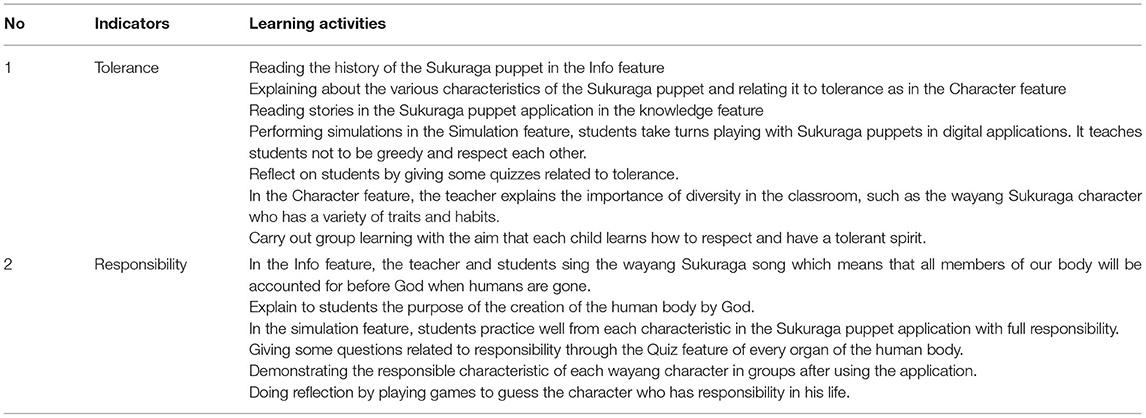
Table 1. Describes the indicators of tolerance and responsibility along with learning activities in the classroom.
Data Analysis Technique
The data analysis process is carried out continuously, both in the field and outside the sector. Analysis is done by organizing, sorting, grouping, coding, and categorizing information. Then, look for cultural themes that can be the main target of research. The main target of this research is deepened through further observation and interviews. During this analysis, it is the information that speaks and therefore the researcher does not interpret. If there is an interpretation, it is the result of the informant's observations and interpretations (Lima et al., 2021).
Results
Character education and responsibility are very important to be developed in schools, especially elementary schools. This is because it will have an impact on the future of the nation, especially during a pandemic, as teachers tend to pay more attention to the cognitive domain compared to the psychomotor and affective domains, especially in character education. At the beginning of the study, when the researcher observed the character of responsibility and tolerance in the research, it was very clear that the teacher was more focused on pursuing learning material than paying attention to changes in attitudes that occurred in the classroom. The learning activities took place in an orderly manner, but the researchers still saw commotion, mocking each other, caring about the cleanliness of the class, unfinished work because they were busy paying attention to the faults of the theme, and other issues. This study aims to analyze the use of Puppet Sukuraga in the form of applications in elementary schools. The research flow begins by collecting data on teachers, students, and principals in an elementary school in grade 2. The data is in the form of interviews and documentation in the form of photos.
Tolerance and Responsibility
Tolerance can be described as one of the attitudes that must be shared by all individuals and groups who live side by side. Because this attitude means that social integrity is shared among individuals in society, therefore the manifestation of this attitude of tolerance must always be maintained in the form of activities and practices in everyday life. To develop the character of tolerance, one way is to use the puppet sukuraga application. Before students get to know the application, students are not introduced to digital- based media (Casmana et al., 2022). They are very enthusiastic to see this apikasi. The development of students' tolerance character through the puppet sukuraga application has increased, at the beginning before this application was used there were still some students who mocked each other. The figure below shows the activities that teacher N uses to solve this problem.
Teacher N invites them to learn about Sukuraga in the character features of the Bi Iwir/Mulutna character. Excerpts from interviews with Teacher N:
“At the beginning I invited all students who witnessed the commotion between students G and L by listening to the story in the application, then continued with the case of student G who almost every day mocked student L because student L has parents who work as Tempers” teacher interview 1
Based on the results of interviews with teacher 1, this incident occurred when student L had a father who was a tempe trader, while student G had a family economic situation that exceeded his friend's because he had a father with a job as a company director. The difference in the economy caused them to mock each other. Then the teacher asked them to get to know the character in the application named Bi Iwir/Mulutna. The character Bi Iwir/Mouthna is the character who plays the noisiest role, meaning the character who talks the most, but Bi Iwir does not like to talk impolitely, Bi Iwir always reminds other characters of tolerance between others, reminds them of the truth, and invites kindness. Character image seen below (Figure 3):
Based on the results of interviews with teacher 1, after they got to know the story and the Sukuraga puppet character named Bi Iwir, they realized that their mouths should be used properly, and helped students whose father was a tempe maker by saying sorry and not repeating his actions. They are aware of the differences between them not to distance themselves from each other but to strengthen each other. The teacher's activities can be seen in the photo below (Figure 4):
In addition to cases of intolerance in terms of ridicule due to differences in economic status, the next instance of intolerance occurs due to differences in physical limitations in the Teacher S class, as shown in the following interview results:
“Student C accepts student D who has physical limitations to play together, because at the beginning student C didn't want to be friends with student D who was deaf and hard to talk to”
“We as teachers are very sad and invite them to make puppets together using paper” teacher interview 4
This case occurred because student C felt annoyed with student D because every time he was spoken to, he was always silent and could not be invited to communicate. Then student C got angry and spoke in a loud voice until student D left. Finally, student D cried and did not want to be friends with student C. Then Teacher 4 shows the puppet character Ceu Eli, this character teaches us to use our ears by listening to good things because it is a great gift to have perfect ears. But a friend who does not have perfect ears does not mean he can't be invited to play, this character teaches students to strengthen each other with the differences around them, meaning that we must have an attitude of tolerance so that we can cover up the imperfections of our friends. Ce u Eli's character in the application can be seen in the image below.
Ce Euli's character has the character of always listening to parents' advice, listening to good words, and faithfully listening to friends' complaints, even though Ce Eui has bad qualities such as often listening to other people's conversations. The attitude of tolerance is exemplified in this character, even though he likes to listen to other people's conversations he does not tell anyone what he was listening to. This means that in addition to teaching tolerance, this character teaches how we must protect the news we hear so that there is no misunderstanding and chaos. Then the next case occurred in a different class where there was a case of physical intolerance, as the following interview results:
Student F has a bone disorder so that his legs are not perfect. Almost all of his friends gave him the name “The Lame.” This resulted in only 1 friend who approached him. Student H wants to get along because he has an older brother with imperfect feet. Student H is used to it. Teacher Interview 3
The foot imperfection that occurs in student F is due to birth. Meanwhile, his family's economic situation is also lacking. Student H had been friends since they were in the same class before. The teacher puts them in the same class at the next level so that F still has friends. Student F does not have perfect feet, but he is good at coloring and drawing so he always wins when he joins a drawing competition. The teacher empowered student F's passion by inviting F and other students to color Kudu Leumpang. Then the teacher made a photo from the results of coloring and showed it to the focus screen. At that time, all of F's friends gave a plus for F's work. They were proud and praised student F. A surprising comment was that one of the students said:
“It's great, F even though the legs are not like us, but the picture is the best among the tips” teacher interview 5
After that the teacher shows Kudu Leumpang in the application. The teacher shouted that this incident was a form of intolerance because they did not understand the differences that God gave us, there must be a lesson. F with his limitations is able to draw and color Kudu Leumpang beautifully. Kudu Leumpang teaches us that God gives us feet as a foundation to step through the process of life, where we will surely meet differences wherever we live. For that we must maintain an attitude of tolerance Imperfections that God gives in the form of fidic to others, of course, we also have limitations in other things. Then the researcher conducted interviews with student F after knowing the character of Kudu Leumpang. The results of the interview are as follows:
During this time, I sometimes get angry with God because of my physical limitations, but today I am grateful that these physical limitations make me even more enthusiastic to always excel because I am aware that other people also have limitations in other forms. F student interview
The results of interviews with teachers and students in this event show that the Wayang Sukuraga helps in learning the characteristic of tolerance. Tolerance comes in terms of accepting differences in physical, economic, and family backgrounds. Tolerance teaches that being open-minded and accepting the shortcomings and strengths of others in life is necessary so that life takes place comfortably (Berkowitz et al., 2020). With tolerance, humans can live complementary, as well as what is desired in making this puppet; each member of the body must complement each other's shortcomings and strengths so that humans can live life with activities that are useful for themselves and their environment. Meanwhile, the results of interviews with schoolteacher are as follows:
“From my discussions with teachers through discussion group forums, we as educators find this application very helpful. This application helps teachers solve cases of intolerance in the classroom, such as often found children who still insult each other, have not been able to accept differences and have not felt that tolerance is needed by humans to maintain comfort. helps teachers in using learning media in class and can be repeated at home, this application reminds ourselves to always take care of our body members by using them for activities that are beneficial to ourselves and the environment around us.” Teacher 2 Interview
The 10 questions answered by the principal show that the application of the wayang sukuraga can develop the character of students, especially in terms of the characteristics of tolerance and responsibility. The principal really appreciates and is happy with the presence of this application in learning at school because it can help teachers in developing tolerance characteristic education in those who have not used the media. According to him, in schools tolerance learning is more about the habit of praying together and ceremonies and through the lecture method. It is rare that media can be used to develop character, moreover this media is a development of the local Sukabumi culture. Meanwhile, the representative of the school committee revealed that:
“This application helps my children forget about other games that are on their cellphones, they are happy to be able to play puppets in digital form, play roles, and sing meaningful folk songs. The song about the ear is a very good song because the song strengthens the function of the ear for children to always listen to the advice or words of their parents. At first they asked why the shape of the Sukuraga puppet is a part of the human body, but they finally understood that every part of our body must work together in carrying out activities, each member of the body has its own responsibility, hopefully the features can be further developed so that children can play while studying” (28 September 2021)
Singing in digital is in the knowledge feature, as shown below (Figure 6):
The song in the literary feature illustrates that the ears were given by God to listen to good things such as listening to teachers while studying, listening to parents' advice, listening to differences of opinion, listening to friends' complaints, and others. In terms of listening to differences of opinion, the advice of older people teaches us that we must have an attitude of tolerance to parents or teachers and, even though we do not want to listen to it, we still respect it. Based on the results of the interview above, we can conclude that tolerance is indispensable in our lives. The Puppet Sukuraga media in the form of an application really helps teachers in developing the character of tolerance. Teaching in the classroom based on the Puppet Sukraga media and the teacher's shrewdness in linking cases with this media greatly helps the development of student tolerance. This is in line with Francis et al. (2018), who showed that to teach and develop character education requires media, methods, and teacher expertise in providing examples and cooperation with school residents to maintain student character in tolerance. Because the character of tolerance is not only taught but requires habituation and application both at home, at school, and in the community (Bacon et al., 2021).
Character development is certainly a major concern in relation to the 2013 curriculum. Responsibility is a state where you have to bear everything. Therefore, accountability is the obligation to bear all and be accountable for the intentional or unintentional acts or actions of a person, based on the acknowledgment of all actions and their consequences for the benefit of others. Responsibility arises because humans live in society and live in a natural environment that requires them not to do what they want to create harmony and balance between humans and God, humans and humans, and humans and nature. Responsibility has a quality that has become part of human life or has become fundamentally important. Everyone has this quality. It is always there in humans, because not everyone can be separated from the life around them. It requires attention and responsibility. As a result, each individual has a different frequency of obligations (Figures 1-9).
The Sukuraga puppet was deliberately created with the aim of conveying moral messages in character education. It also reminds us that we as humans have a responsibility to function properly using our body parts. Looking back at the problems that occur in schools, of course wayang sukuraga can help provide character education for students. The problems at school from the results, observations, and interviews as well as documents in the form of photos are described as follows. The first problem was present at the beginning before the Puppet Sukuraga application was used as a learning medium; some teachers complained that the homework that students did in online learning was often done by their parents, so that students did not understand the concept because they were accustomed to not having responsibility for their work. This is reinforced by the following interview results:
“I am disappointed with the results of the homework during the pandemic, the homework is done by their parents. Besides that, they are not honest in saying that it is not the result of their hard work.” Teacher interview 2 (1 Oktober 2021)
This makes teachers have to repeat learning and assignments at school. The responsibility of the students is low. Students also feel certain that the teacher will forgive them because of the limitations of the situation. The situation during the pandemic with the background of family differences is very influential on learning outcomes and students' sense of responsibility. The teacher tried other alternative activities by giving additional assignments, but it was still found that the students were less responsible. Then the teacher gives the Puppet Sukuraga application to help learning. The teacher introduces the character Panona as shown below:
The teacher explains the character features in Socana/Pa Anon who have bad traits like peeking and seeing things that are forbidden, while his good nature likes to study and observe. Pa Anon in eliminating his bad nature diverts the desire to peek or see things that are not good by learning seriously through reading activities, both reading books and reading those around us. After getting to know this character, most of the students began to honestly say that the homework was done by their parents. Their parents are too busy with work to do their work online at home. Students begin to realize that their attitude of responsibility must be improved, they start doing their homework on their own, even though there are less results, the teacher emphasizes learning from mistakes The next case is in a different class; student J fights with student M, because M has stolen his pocket money. M's habit is to steal because M comes from a poor family, sometimes M doesn't have money for snacks, so sometimes M asks J for money. According to J:
“I often asked M to return his pocket money but J insisted, this happened not only once so he felt annoyed. But M did not accept because J also promised that if he helped J in completing his homework, M would be given money as a token of gratitude.” Interview students 9 and 12 (8 Oktober 2021)
Students are introduced to the character Leuangka in the application, at the beginning they do not want to see it but the teacher tries to invite them starting with the story in the wayang Sukuraga, where Leuangka is the most responsible character in terms of overcoming problems in story conflicts. The figure of Leungka is shown below.
In terms of fighting, the character of the hands and feet in the wayang sukuraga also gives a moral message to always use our hands for good things such as alms, helping people, and more. The character of the feet in the tribal wayang also gives a moral message to use the feet to step toward a place that can help achieve goals. Meanwhile, the results of interviews and pictures from the principal of the school conducted online via google meet are summarized below:
“The atmosphere in the classroom that is guided by the teacher in the use of the Sukuraga wayang application is different from before. The responsibilities of students who are complained about by the teachers begin to decrease after students understand their responsibilities ” Teacher Interview (7 November 2021)
The photo shows the activities carried out by researchers to explore information on the impact of using the Wyang Sukuraga application. The principal feels that there is a difference in the character of student responsibility after using this application. It is proven that complaints from teachers about the lack of character of student responsibility are starting to decrease.
Furthermore, the Quiz feature is part of the application that is very popular with students because they are not only directed to think before acting, but also experience the comments expressed by the teacher. The following is a picture of the Quiz feature and the results of interviews with teachers.
Excerpts from the interview with the Class 2 Committee are summarized as follows:
“The Quiz feature is a feature that students have been waiting for. Students at the beginning were introduced to all the features in the application, but the Quiz feature I showed at the end. My class becomes quieter because of using this medium. because of their discipline after using the application, they are more confident with the results of their work, are responsible for carrying out tasks, both independently and collectively after getting to know this application.” Committee Interview 2
The quiz feature in this application relates to the responsibilities of the five senses that God has given us. In this quiz, students are asked to answer the functions of the five senses, hands, and feet. Then the user is asked to answer the responsibilities of each character in the Wayang Sukuraga. Even more interestingly, this quiz feature is accompanied by a typical song from the region so that users, especially children, do not forget the culture of their country. The results of interviews with parents/school committees concluded that they felt happy and enthusiastic about the existence of learning media in the form of applications. This is because this application makes children aware of their responsibilities as children and as students. As children, they listen more to reprimands and advice from their parents. As students they are more responsible in doing the tasks given by the teacher. The committee gave suggestions to add depth to the material of responsibility and to add features of interesting stories and distinctive songs accompanied by regional songs.
Responsibility character education in the United States has been seriously and comprehensively developed from the national level to the school level. This was based on the survey results which stated that 90% of respondents stated that responsibility character education was needed and needed to be developed in schools. In line with Medison's (2018) statement citing survey results stating that America, which is known as a country that adheres to the ideology of freedom, also has a way of developing the character of responsibility through behavioral education programs and inculcating good moral values to students in schools (Luliano et al., 2018). Meanwhile, the development of the character of responsibility has also been carried out in the northern part of Indonesia by collaborating between teachers and counseling teachers using the Student Team Achievement Division method (Afnibar et al., 2020). In Indonesia, in addition to character education, responsibility is included in the curriculum and through the development of teaching materials and habits, but has not used media such as Puppet of Sukuraga. Furthermore, research on the application of the character of tolerance in Malaysia is carried out by incorporating it into student teaching materials and through habituation. In the central part of the island of Java, Indonesia, research on the character of tolerance was carried out by civics teachers with the basis of Islamic boarding school education, as a result, the tolerance characteristic of students increased (Benaziria and Murdiono, 2020). In this study, the method is not used but uses the puppet Sukuraga media to develop character education, especially the characteristics of tolerance and responsibility. Indonesia has Wayang which is an imitation of people made of leather or wood carvings that can be used to play characters in wayang story performances (traditional dramas) in Java, Bali, Sunda, and so on which are usually played by someone called the dalang to the accompaniment of traditional music gamelan.
Character research using wayang has been carried out in other areas, such as the research conducted by Halimah et al. (2020). The difference is that Leli uses wayang golek media from the province of West Java. This study seeks to see the use of wayang golek in improving the kinesthetic of wayang golek stories (Halimah et al., 2020). The puppet show is a puppet originating from West Java in the form of wood, while at the researcher's place using Puppet Sukuraga in the form of an application. Researchers have limitations in terms of taking data from teachers because time is limited, and in hybrid learning not all teachers do, so researchers take the results of interview instruments using online and face-to-face methods. Face-to-face meetings take a long time due to the small number of students who take turns entering class, and it is still only 1 day a week that students are allowed to bring cellphones to school, so researchers feel that they are not optimal.
Discussion
Based on the data and research results above, we can conclude that tolerance is indispensable in our lives. The Sukuraga Puppet Media in the form of an application is very helpful for teachers in developing the characteristic of tolerance. Teaching in the classroom based on the Wayang Sukraga media and the shrewdness of the teacher in linking cases with the media greatly helps the development of student tolerance. In line with Francis et al. (2018), teaching and developing character education requires media, methods, and teacher expertise in providing examples and collaboration with school members to maintain student character in tolerance. Because the characteristic of tolerance is not only taught but requires habituation and application both at home, at school, and in the community (Park and Sim, 2022). Puppet Sukuraga was deliberately made with the aim of conveying a moral message in character education. It also reminds us that we as humans have a responsibility to function properly using our body parts. Looking back at the problems that occur in schools, of course wayang sukuraga can help provide character education for students.
Secondary data, namely, the results of interviews with parents/school committees concluded that they felt happy and enthusiastic about the existence of learning media in the form of applications and recommended that local culture be integrated into teaching materials in schools. In line with Daga's research, he compared character education in the basic education curriculum of three countries: Malaysia, India, and Indonesia. The results show that character education has become one of the important components in curriculum development both as a document and in actual implementation in the classroom. The three countries in terms of character values and character education implementation strategies have similarities and differences. But the most important thing is that the three countries are not only aware of the importance of character education for the younger generation but have implemented it in education programs and implementations in their respective countries (Daga, 2021). Likewise, Malaysia has integrated tolerance character education into learning and habituation materials.
This research using puppets has also been carried out by Halimah et al. (2020), but the difference in the research lies in the improvement of the kinesthetic of wayang golek made of wood. Researchers use Puppet Sukuraga in application form (Syafrini et al., 2020). Puppet Sukuraga in terms of form and philosophy of wayang is very different. This study has limitations in terms of collecting data from teachers due to limited time, so the researchers took the instruments from interviews using online and face-to-face methods. Face-to-face meetings take a long time because there are few students who take turns entering class, and it is still only 1 day a week that students are allowed to bring cellphones to school, so researchers feel that they are not optimal.
Conclusion
Based on the results and discussion, it is concluded that character learning can be developed through the Puppet Sukuraga application. Unlike other puppets, wayang in the form of this application can be used in online and offline learning, so that it can help teachers both in class and outside the classroom. This application can also be used by all ages because it can be downloaded via the google playstore. As a learning medium, this application has features where students can learn the history, philosophy of wayang sukuraga, sing, play wyaang through simulation games, and quizzes. Learning outcomes in schools show that this application supports the development of student character. The most prominent student character and often seen after using this application is the character of tolerance and responsibility. Tolerance characteristics include students beginning to appreciate differences between friends and their environment, politeness in speech, respect for differences in preferences, respect for differences of opinion, and not differentiating between religion, race, and culture in playing and learning. The second developed characteristic of students is the character of responsibility; students are more responsible in carrying out their duties, doing their own homework, using their eyes by not cheating on their friends' work, using their ears by listening to the teacher when explaining lessons, and so on.
The application of wayang sukuraga has implications for learning in elementary schools, especially in developing character education. This application helps learning in the classroom and at home, so that the character of students can improve. This application is useful for developing the characteristic of tolerance which is felt to be very necessary for socializing at school so that the learning conditions are comfortable. In addition, this application helps develop the characteristic of responsibility, based on the results of interviews and observations from students, teachers, principals, and school committees.
It is suggested that for future researchers, they can discuss and learn more about the use of other applications that can benefit character education. In addition, how the teachers use the application as a controlling system for teaching character could be examined. In the meantime, it is difficult to let students learn character on the application only, so it needs to be deeply understood how to use this application.
Data Availability Statement
The original contributions presented in the study are included in the article/supplementary material, further inquiries can be directed to the corresponding author.
Ethics Statement
The studies involving human participants were reviewed and approved by Ethical Committee of Universitas Muhammadiyah Sukabumi. The patients/participants provided their written informed consent to participate in this study.
Author Contributions
All authors listed have made a substantial, direct, and intellectual contribution to the work and approved it for publication.
Conflict of Interest
The authors declare that the research was conducted in the absence of any commercial or financial relationships that could be construed as a potential conflict of interest.
Publisher's Note
All claims expressed in this article are solely those of the authors and do not necessarily represent those of their affiliated organizations, or those of the publisher, the editors and the reviewers. Any product that may be evaluated in this article, or claim that may be made by its manufacturer, is not guaranteed or endorsed by the publisher.
References
Afnibar, A., Amalia, A., Nasrul, D. F., and Rahmi, A. (2020). Children worth school: Psychological well-being of high school students in Padang. Al-Ta'lim J. 27. Available online at: http://journal.tarbiyahiainib.ac.id/index.php/attalim/article/view/632/373
Agussalim, A., Widjaja, S. U. M., Haryono, A., and Wahyono, H. (2021). Pancasila economic character literacy program for high school students. Int. J. Instr. 14, 235–252. doi: 10.29333/iji.2021.14114a
Aragona-Young, E., and Sawyer, B. E. (2018). Elementary teachers' beliefs about multicultural education practices. Teach. Teach. 24, 465–486. doi: 10.1080/13540602.2018.1435527
Bacon, C. E. W., Lacy, A. M. P., and Lam, K. C. (2021). Knowledge translation in athletic training: considerations for bridging the knowledge-to-practice gap. J. Athl. Train. 56, 1165–1172. doi: 10.4085/0470-20
Benaziria, B., and Murdiono, M. (2020). Civic teacher strategy in the integration of nationalism and tolerance character in school based on pesantren in Yogyakarta city. J. Soc. Sci. 15, 13–34. doi: 10.21831/jss.v15i1.25227
Berkowitz, M. W., Lickona, T., Nast, T., Schaeffer, E., and Bohlin, K. (2020). The eleven principles of effective character education: A brief history. J. Charact. Educ. 16, 1–10. Available online at: https://www.proquest.com/openview/63e55f1748ad32d7d8123787c67d2b76/1?pq-origsite=gscholar&cbl=27598
Bohlin, K. E., Farmer, D., and Ryan, K. (2001). Building Character in Schools Resource Guide. The Jossey-Bass Education Series. ERIC.
Brookes, A. (2003). A critique of neo-Hahnian outdoor education theory. Part one: Challenges to the concept of “character building.” J. Adventure Educ. Outdoor Learn. 3, 49–62. doi: 10.1080/14729670385200241
Campbell, S. (2018). Javanese culture and the meanings of locality: studies on the arts, urbanism, polity, and society, by Bagoes Wiryomartono. Asian Stud. Rev. 42, 563–564. doi: 10.1080/10357823.2018.1436854
Carlsen, G. A. (2019). Brazilian boys riding Indonesian waves: orientalism and fratriarchy in a recent Brazilian surf movie. Postcolonial Stud. 22, 238–251. doi: 10.1080/13688790.2019.1611365
Casmana, A. R., Dewantara, J. A., Timoera, D. A., Kusmawati, A. P., and Syafrudin, I. (2022). Global citizenship: preparing the younger generation to possess pro-environment behavior, mutual assistance and tolerance awareness through school engagement. Glob. Soc. Educ. 2022, 1–18. doi: 10.1080/14767724.2021.2013167
Cohen, L., Manion, L., and Morrison, K. (2002). Research Methods in Education. Routledge. doi: 10.4324/9780203224342
Cohen, M. I. (2007). Contemporary “Wayang” in global contexts. Asian Theatre J. 2007, 338–369. doi: 10.1353/atj.2007.0032
Cohen, M. I. (2016). Global modernities and post-traditional shadow puppetry in contemporary southeast Asia. Third Text 30, 188–206. doi: 10.1080/09528822.2017.1305728
Cohen, M. I. (2017). Puppets, puppeteers, and puppet spectators: a response to the volkenburg puppetry symposium. Contemp. Theatre Rev. 27, 275–280. doi: 10.1080/10486801.2017.1298100
Daga, A. T. (2021). Implementing character education during the covid-19 pandemic at elementary school. Primary: Jurnal Pendidikan Guru Sekolah Dasar. 10, 836–853. doi: 10.33578/jpfkip.v10i4.8448
Darder, A. (2011). Teaching as an act of love: reflections on paulo freire and his contributions to our lives and our work. Counterpoints 418, 179–194. Available online at: http://www.jstor.org/stable/42981647
Domek, G. J., Szafran, L. H., Bonnell, L. N., Berman, S., and Camp, B. W. (2020). Using finger puppets in the primary care setting to support caregivers talking with their infants: A feasibility pilot study. Clin. Pediatr. 59, 380–387. doi: 10.1177/0009922820903407
Ewing, R. (2020). The Art and Australia Education: Realising Potensial. Camberwell, VIC: Acer Press. Available online at: https://research.acer.edu.au/cgi/viewcontent.cgi?referer=&httpsredir=1&article=1020&context=aer
Fajrie, N., Purbasari, I., and Setiawan, D. (2021). Analysis of the wood production machine process for the application of wayang klitik technology. J. Phys. Conf. Ser. 1823, 012034. doi: 10.1088/1742-6596/1823/1/012034
Foley, K. (2016). Arifin and Putu: Teater Modern acting in New Order Indonesia. Theatre Dance Perform. Train. 7, 472–484. doi: 10.1080/19443927.2016.1217266
Francis, L. J., Pike, M. A., Lickona, T., Lankshear, D. W., and Nesfield, V. (2018) Evaluating the pilot narnian virtues character education english curriculum project: a study among 11- to 13-year-old students. J. Belief Value. 39, 233–249. doi: 10.1080/13617672.2018.1434604
Fredin, S., and Jogmark, M. (2017). Local culture as a context for entrepreneurial activities. Eur. Plan. Stud. 25, 1556–1574. doi: 10.1080/09654313.2017.1306028
Freire, P. (2021). Pedagogy in Process: The Letters to Guinea-Bissau. London: Bloomsbury Publishing. doi: 10.5040/9781350190337
Gander, F., Waqner, L., Amann, L., and Ruch, W. (2021). Menulis artikel dengan judul : What are character strengths good for? A daily diary study on character strengths enactment. J. Posit. Psychol. doi: 10.1080/17439760.2021.1926532
Garzon, A. M. M., Silva, K. L., and Marques, R. C.. (2018). Liberating critical pedagogy of Paulo Freire in the scientific production of Nursing 1990-2017. Rev. Bras. Enferm. 71, 1751–1758. doi: 10.1590/0034-7167-2017-0699
Halimah, L., Arifin, R. R. M., Yuliariatiningsih, M. S., Abdillah, F., and Sutini, A. (2020). Storytelling through “Wayang Golek” puppet show: Practical ways in incorporating character education in early childhood. Cogent Educ. 7, 1. doi: 10.1080/2331186X.2020.1794495
Hijjas, M. (2017). Marks of many hands: Annotation in the Malay manuscript tradition and a Sufi compendium from West Sumatra. Indones. Malay World 45, 226–249. doi: 10.1080/13639811.2017.1324688
Jones, T. (2018). International intangible cultural heritage policy in the neighbourhood: an assessment and case study of Indonesia. J. Cult. Geogr. 35, 362–387. doi: 10.1080/08873631.2018.1429351
Juliana Jaya, P. E., Utama, M. S., Murjana Yasa, I. G. W., and Yuliarmi, N. N. (2020). Improving competitiveness and well-being through human resources quality, local culture, and product performance. Cogent Bus. Manag. 7:1831247. doi: 10.1080/23311975.2020.1831247
Karolčík, Š., Cipková, E., and Mázorová, H. (2016). Application of digital technologies in the geography teaching process from the teachers' perspective. Int. Res. Geogr. Environ. Educ. 25, 328–343. doi: 10.1080/10382046.2016.1207992
Lima, W., Northover, K., Hewitt, G., and Newell-McLymont, E. F. (2021). Teacher collaboration: The need for trust in the classroom context. Int. J. Eng. Manag. Res. 11, 152–164. doi: 10.31033/ijemr.11.2.22
Ludvigson, D., Stolare, M., and Trenter, C. (2021). Primary school pupils learning through haptics at historical sites. Education 3–13. doi: 10.1080/03004279.2021.1899260
Luliano, A. D., Roguski, K. M., Chang, H. H., Muscatello, D. J., Palekar, R., Tempia, S., et al. (2018). Estimates of global seasonal influenza-associated respiratory mortality: A modelling study. Lancet 391, 1285–1300. doi: 10.1016/S0140-6736(17)33293-2
Moffat, A. K., Redmond, G., and Raghavendra, P. (2019). The impact of social network characteristics and gender on covert bullying in Australian students with disability in the middle years. J. Sch. Violence 18, 613–629. doi: 10.1080/15388220.2019.1644180
Nurgiyantoro, B. (2011). Wayang dan pengembangan karakter bangsa. J. Pendidik. Karakter. 1:232. doi: 10.21831/cp.v1i3.232
Olsen, J., Preston, A. I., Algozzine, B., Algozzine, K., and Cusumano, D. (2018). A review and analysis of selected school climate measures. Clear. House J. Educ. Strateg. Issues Ideas 91, 47–58. doi: 10.1080/00098655.2017.1385999
Palar, M. R. A., and Rasiah, R. (2019). Universalization of Indonesian cultural and scientific regulations. Afr. J. Sci. Technol. Innov. Dev. 11, 873–882. doi: 10.1080/20421338.2019.1588510
Park, S., and Sim, Z. M. (2022). Tolerance as implicit order: militias and sexual violence as practice in indonesian counterinsurgency operations. J. Interv. Statebuilding 16, 18–39. doi: 10.1080/17502977.2020.1838760
Prasetiyo, W. H., Ishak, N. A., Basit, A., Dewantara, J. A., Hidayat, O. T., Casmana, A. R., et al. (2020). Caring for the environment in an inclusive school: The Adiwiyata Green School program in Indonesia. Issues Educ. Res. 2020:18.
Riany, Y. E., Meredith, P., and Cuskelly, M. (2017). Understanding the influence of traditional cultural values on Indonesian parenting. Marriage Fam. Rev. 53, 207–226. doi: 10.1080/01494929.2016.1157561
Sarkadi, D., Casmana, A. R., and Rahmawati, Y. (2020). Improved learning design for pre-service teacher in a character education course. Univers. J. Educ. Res. 8, 212–224. doi: 10.13189/ujer.2020.080126
Sarkadi, S., Casmana, A. R., Cahyana, U., and Paristiowati, M. (2020a). The Application of Mobile Learning for University Students in the Pancasila Education Modul in Developing Character of Students' Empathy. Univers. J. Educ. Res. 8, 3825–3833. doi: 10.13189/ujer.2020.080905
Sarkadi, S., Syarifa, S., and Casmana, A. R. (2020b). The policy of education based on character values for the best quality of education “an analysis of the zoning system policy imposed by ministry of education and culture in Indonesia.” Univers. J. Educ. Res. 8, 3423–3429. doi: 10.13189/ujer.2020.080816
Shipper, A. W. (2016). Politics through the lens of language, literature, films, and Wayang : Remembering Benedict Anderson. Crit. Asian Stud. 48, 302–304. doi: 10.1080/14672715.2016.1168594
Shoshani, A. (2019). Young children's character strengths and emotional well-being: Development of the Character Strengths Inventory for Early Childhood (CSI-EC). J. Posit. Psychol. 14, 86–102. doi: 10.1080/17439760.2018.1424925
Sumadi, T., Abdillah, F., and Casmana, A. R. (2021). A pattern of tolerance values transformation by parents towards early childhood. Front. Educ. 6, 13. doi: 10.3389/feduc.2021.626680
Syafrini, D., Fadhil Nurdin, M., Sugandi, Y. S., and Miko, A. (2020). The impact of multiethnic cultural tourism in an Indonesian former mining city. Tour. Recreat. Res. 45, 511–525. doi: 10.1080/02508281.2020.1757208
Thumel, M., Jastrow, F., Kridger, C., Schwedler, A., and Subenbach, J. (2020). The use of digital media in primary school PE - student perspectives on product-oriented ways of lesson staging. J. Phys. Educ. Sport Pedag. 27, 43–58. doi: 10.1080/17408989.2020.1849597
Vidergor, H. E. (2021). Effects of digital escape room on gameful experience, collaboration, and motivation of elementary school students. Comput. Educ. 166:104156. doi: 10.1016/j.compedu.2021.104156
Walker, L. J. (2020). The character of character: The 2019 kohlberg memorial lecture. J. Moral Educ. 49, 381–395. doi: 10.1080/03057240.2019.1698415
Williamson, K. (2014). Malaysian Cinema in a Bottle: a century (and a bit more) of wayang. Hist. J. Film Radio Telev. 34, 646–648. doi: 10.1080/01439685.2014.943966
Winangun Persada, K. (2018). Perancangan Informasi Melalui Media Film Dokumenter Wayang Sukuraga Wayang. Sukuraga.
Wintersteiner, W. (2019). “Peace education for global citizenship,” in The Genuine Global Dimension of Betty Reardon's Concept of Peace Education: Exploring Betty A. Reardon's Perspective on Peace Education. Pioneers in Arts, Humanities, Science, Engineering, Practice, Vol 20, ed D. Snauwaert (Cham: Springer). doi: 10.1007/978-3-030-18387-5_2
Wiśniewska, M. (2020). On hybridity in puppetry. Perform. Res. 25, 56–64. doi: 10.1080/13528165.2020.1842032
Keywords: cultural values integration, character development, elementary schools, the Sukuraga puppets, learning media
Citation: Nurasiah I, Sumantri MS, Nurhasanah N and Casmana AR (2022) Cultural Values' Integration in Character Development in Elementary Schools: The Sukuraga as Learning Media. Front. Educ. 7:849218. doi: 10.3389/feduc.2022.849218
Received: 05 January 2022; Accepted: 21 March 2022;
Published: 12 May 2022.
Edited by:
Bibiana Regueiro, University of Santiago de Compostela, SpainReviewed by:
Donny Adiatmana Ginting, Medan, IndonesiaNurul Khairina, Universitas Medan Area, Indonesia
Copyright © 2022 Nurasiah, Sumantri, Nurhasanah and Casmana. This is an open-access article distributed under the terms of the Creative Commons Attribution License (CC BY). The use, distribution or reproduction in other forums is permitted, provided the original author(s) and the copyright owner(s) are credited and that the original publication in this journal is cited, in accordance with accepted academic practice. No use, distribution or reproduction is permitted which does not comply with these terms.
*Correspondence: Iis Nurasiah, aWlzbnVyYXNpYWhAdW1taS5hYy5pZA==; aWlzbnVyYXNpYWhfOTkxOTkyMTAwMUBtaHMudW5qLmFjLmlk
 Iis Nurasiah
Iis Nurasiah Mohamad Syarif Sumantri2
Mohamad Syarif Sumantri2 Asep Rudi Casmana
Asep Rudi Casmana
